Ants, which are social insects and thrive in colonies, have a remarkable level of success. A colony includes queens, workers, eggs, larvae, and pupae. The primary duty of worker ants is to sustain and safeguard the nests. These nests serve as both protection against threats and refuge from harsh weather conditions. In order to ensure access to water and food sources, they are strategically located.
Some ant species nest underground, often beneath concrete or slabs, while others inhabit wood like fence posts, dead logs, and hollow trees. They can also be found within structures. Ants have a head, a thorax (or mid-section), and an abdomen that is connected to the thorax by a brief, narrow stalk. Their mouths and mouthparts, located on their heads, serve for both food transportation and defense purposes.
Ants have two compound eyes and multiple single eyes. The compound eyes detect movement, while the single eyes detect light. Ants possess two stomachs: a single stomach for food digestion and a crop stomach. The single stomach stores food, and the crop stomach contains food for the colony during times of scarcity. When an ant is hungry, it communicates this by signing with its antennae to another ant.
Ants use food requests as a form of communication. When an ant gets this message, it regurgitates food for the hungry ant to consume. Certain ants possess stingers or, in uncommon situations, are capable of emitting poison from their abdomens. Ants come in different sizes, ranging from tiny at 0.08 inches to a remarkable two inches.
Despite their small size, ants have a vital role on Earth. To give an idea of their significance, the total weight of ants is probably equal to that of the entire human population. With a worldwide population reaching approximately 6 billion individuals, the sheer number of ants is truly astonishing! Although scientists have identified over 8,800 ant species up until now, they believe that there are still over 20,000 ant species awaiting discovery.
References
- Warner T. Johnson. 1995. Insects that Feed on Trees and Shrubs. 2nd ed. Jackson, N.J. P123
- Randall J. Schuh. 1997. True Bugs of the World. John Wiley. N.J. P96
- http://www.orkin.com/ants/antsindex.html
- http://accupest-bugfree.com/html/ants.html





